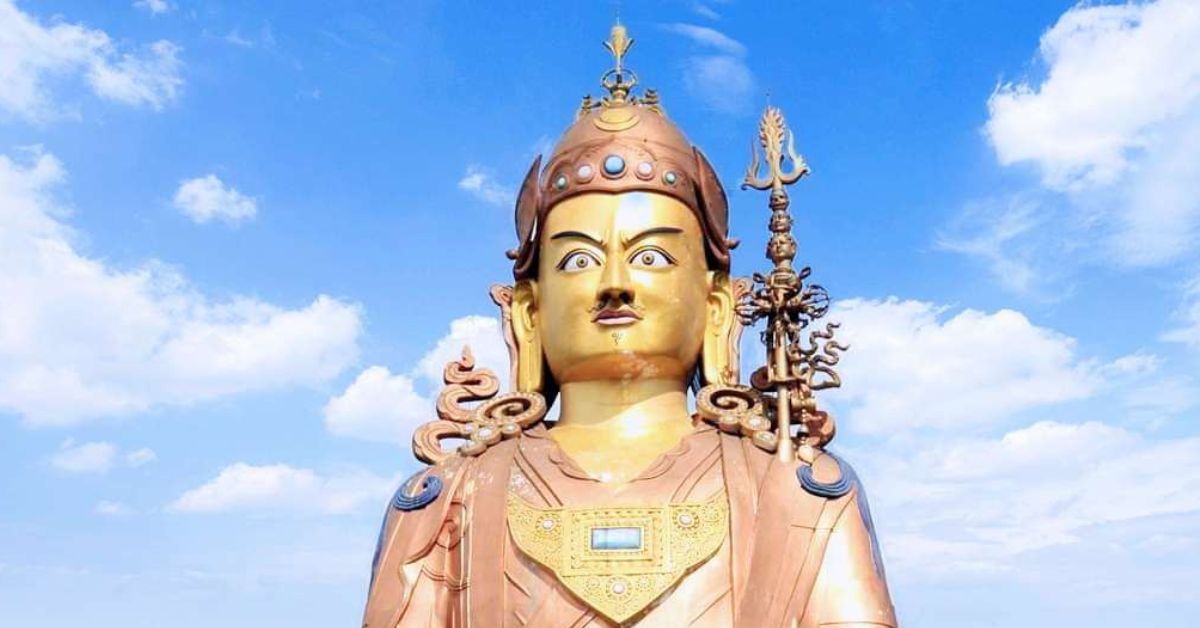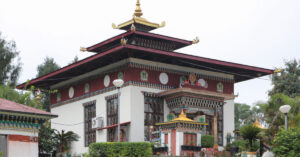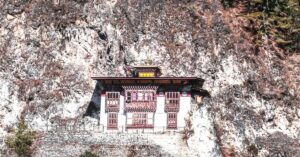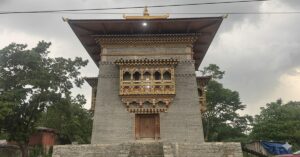Guru Rinpoche is one of Bhutan’s most important historical and religious figures who introduced Buddhism. He is considered the reincarnation of the Lord Buddha and is referred to as the Second Buddha. The statue of Ugyen Guru Rimpoche appears in altars of almost all Bhutanese temples and homes.
Guru Rinpoche is also known as Padmasambhava, which in Sanskrit means ”born from a lotus flower.” In Bhutan, Padmasambhava is known as Ugyen Guru Rimpoche.
What is the importance of Guru Rinpoche? He is revered as Bhutan’s second most significant figure, after Buddha Shakyamuni. Bhutan’s third significant figure is Zhabdrung Ngawang Namgyal. Guru Rimpoche visited Bhutan three times and blessed several religious sites across the country in the 8th century. Pilgrims from across the world visit these sites, revered as sacred Neys.
So, here’s a brief Guru Rinpoche story. It is all about Guru Rinpoche’s biography and his contributions to Bhutan.
Early Life of Guru Rinpoche
Who is Guru Rinpoche? When was Guru Rinpoche born? Guru Rinpoche was born in 717 AD in the Kingdom of Oddiyana. Buddha Shakyamuni predicted Guru Rimpoche’s birth and activities in 19 Sutras and Tantras. Buddha stated that an emanation of Amitabha and Avalokiteśvara would be born after 12 years of his death. According to the prophecy, Guru Rimpoche was born consciously as an eight-year-old child in 717 AD. He had a miraculous birth in Lake Dhanakosha from the center of a lotus in the kingdom of Oddiyana, the Swat Valley of present-day Pakistan. Based on other theories, the kingdom of Oddiyana is considered to be Thankosh in Sambalpur, Odisha, India.
Birth Anniversary of Guru Rinpoche in Bhutan
The Birth Anniversary of Guru Rinpoche is observed on the 10th day of the 5th month of the Bhutanese calendar in Bhutan. He was born 12 years after Buddha attained Parinirvana.
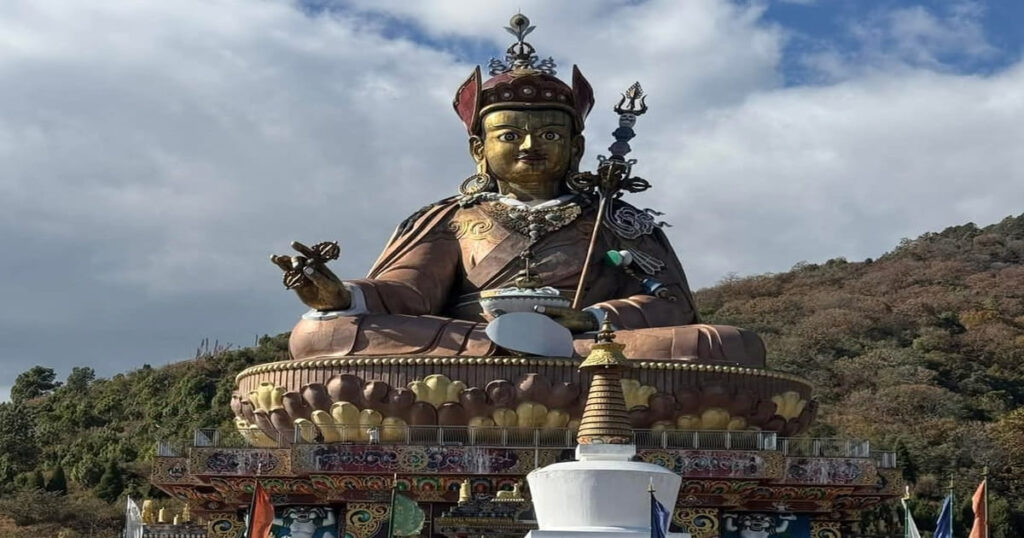
Guru Rinpoche’s Visit to Bhutan
The history of Guru Rinpoche in Bhutan indicates that Guru Rinpoche came to Bhutan three times. So, when did Guru Rinpoche come to Bhutan? Guru Rimpoche first came to Bhutan in 810 A.D. from Nepal in the year of the Iron Tiger. The second and third visits were from Tibet.
Guru Rinpoche subdued many evil spirits during his visits to Bhutan and converted them into the protecting deities of different valleys. He also meditated and blessed many places as sacred pilgrimage sites (Neys) throughout the country. He even hid many treasures (Ters) to be rediscovered by Tertons (treasure revealers).
Guru Rimpoche’s visit to Bhutan has tremendously impacted Bhutanese society, as his teachings and contributions are revered in Bhutanese religion and history. Bhutan is therefore regarded as the Beyul (hidden land), the legacy of Guru Rimpoche. So, why did Guru Rinpoche come to Bhutan?
Why did Guru Rinpoche come to Bhutan?
Why Guru Rinpoche came to Bhutan? Guru Rinpoche came to Bhutan to recover the life force (sog) of King Sindhu Raja snatched by the local deity, Shelging Karpo.
Guru Rimpoche’s visit to Bhutan has a long history. Indian prince Sendha Gyab was exiled from India in the 8th century. He eventually settled in Bhutan, becoming the ruler of Bumthang. Once Sindhu Raja became the ruler of Bumthang, he had a conflict with King Naochhe, or ‘Big Nose’, to the south.
The King Sindhu Raja, before sending his troops into war with Naochhe, including his son, prayed to pre-Buddhist local deities for their safety. However, the son of Sindhu Raja was killed during the fighting, causing the King to become resentful of the local deities. Sindhu Raja then ordered his men to destroy religious sites. This act angered local deities, particularly the chief protective deity, Shelging Karpo. Shelging Karpo thus aimed to kill Sindhu Raja by stealing his ‘life essence’, or his soul. As a result, Sindhu Raja slowly became ill, unable to be healed by any astrologers or local shamans.
At that time, Guru Rimpoche’s supernatural powers were well-known throughout the Himalayan region. As a final effort, one of Sindhu Raja’s ministers invited Guru Rinpoche in hopes of healing King Sindhu Raja.
Buddhism in Bhutan
Who brought Buddhism to Bhutan? The first signs of Buddhism in Bhutan are the two temples of Jampay Lhakhang in Bumthang and Kyichu Lhakhang in Paro, monuments which are believed to have been built by the Tibetan King Songtsen Gampo in 659 CE. However, the arrival of Guru Rimpoche in the middle of the 8th century marked the proper advent of Buddhism to Bhutan. Guru Rinpoche not only brought Buddhism to the country but also visited and blessed many places that have now become sacred pilgrimage sites for devotees from around the globe. Later, Phajo Drugom Zhigpo and Zhabdrung Ngawang Namgyal brought Drukpa Kagyu to the country.
According to the biography of Phajo Drugom Zhigpo, “The Current of Compassion”, Phajo Drugom Zhigpo traveled to Taktsang Senge Samdrup Dzong in the 13th century following a prophetic direction from Tsangpa Gyare. While Phajo was meditating in Taktsang Palphug, Guru Rinpoche appeared to him in an unmistakable clear vision one early morning and said, “I am entrusting to you my twelve meditation places, consisting of four fortresses (dzongs), four cliffs (drak), and four great caves (phug); you have to plant the Victory Banner of Practice in all of these.”

Sacred Pilgrimage Sites of Guru Rinpoche in Bhutan
The sacred pilgrimage sites of Guru Rimpoche are spread across the country. These pilgrimage sites hold great spiritual significance and blessings, and visiting them is said to help remove defilements and obstacles on the path to enlightenment.
Guru Rinpoche’s First Visit to Bhutan
The first visit of Guru Rinpoche to Bhutan was in 810 AD. He first came to Bhutan from Nepal via Nabji Korphu in the Trongsa Dzongkhag. He traveled to the Kingdom of Bumthang at the invitation of King Sindhu Raja of Bumthang to recover his life force (sog) snatched by the local deity, Shelging Karpo.
After meditating in a cave, Guru Rimpoche subdued Shalging Karpo, leaving his body print on the cave. Therefore, the cave is considered sacred and is known as Kurje. Later, Chogyal Minjur Tempa built Kurjey Lhakhang in 1652.
While returning to Nepal, on the border between Bhutan and India, Guru Rinpoche made peace between the two kings, Sindhu Raja and Nawoche. The two kings took vows to end their conflict. A stone pillar of oath (Nado) was erected as a border demarcation. This border is identified as the present-day Nabji village. We can still find the stone pillar standing on this site. Guru Rimpoche also hid many religious treasures in the Nabji vicinity and blessed the area as a hidden land. Khandro Tashi Khyidren built Nabji Lhakhang at the stone pillar site. While in Trongsa, he also visited and blessed Guru Lhakhang in Sinphu.
Also Read: 2 Holiest Sites Blessed by Guru Rinpoche During His First Visit to Bhutan
Second Visit of Guru Rinpoche in Bhutan
Guru Rinpoche’s second visit to Bhutan. The second visit of Guru Rinpoche in Bhutan was in the year 822 AD. Guru Rinpoche came to Bhutan for the second time with Khandro Yeshe Tshogyal from Tibet. His second visit was following the prophecy and their destiny to subdue evil spirits and spread Buddhism, visited Bhutan for the second time and blessed several places, considered sacred pilgrimage sites today.
Bumthang
While in Bumthang, he meditated and blessed Tang Rimochen Lhakhang and Thowadrak Monastery. Guru Rimpoche also visited Kunzangdrak Monastery riding on the back of his tigress. He then meditated at Zhabjethang Lhakhang (not to be confused with Zhabje Lhakhang in Wangdue) and left his imprints on the rock. He also blessed Choedrak Monastery and Shudrak Goenpa and hid many treasures in Membartsho, the burning lake in Bumthang.
Also Read: Dra Zhi, the Four Great Meditation Cliffs of Guru Rinpoche
Guru Rinpoche in Eastern Bhutan
After blessing many places in Bumthang, Guru Rimpoche traveled to Eastern Bhutan. In Trashiyangtse, he meditated at Gomphu Kora and subdued the local deity. Guru Rinpoche also visited and blessed Gongza Ney, Dechen Phodrang Ney, and Omba Ney. He then went on to bless the Aja Ney valley in Monggar Dzongkhag as a Beyul (Hidden Land), one of the three sacred sites of Guru Rinpoche. In Lhuentse, Guru Rimpoche visited Neychhen Rinchen Bumpa and Singye Dzong.
Paro
After meditating and blessing the site, Guru Rinpoche finally flew from Singye Dzong in Lhuntse to Paro Taktsang (Tiger’s Nest) on a flaming tigress. He meditated at Taktsang cave for three months. He then started visiting many places in the western region. Other prominent places Guru Rimpoche visited and blessed in Paro Valley are Drakarpo, Namthong Karpo or Zuri Dzong, Dzongdrakha, Ragoe Ney Monastery, Gomdrak, Chumphu Ney, and Tshelung Ney. He also visited Paro Kyichu Lhakhang, built by Songtsen Gampo, and Pangbisa Ugyen Guru Lhakhang.
Also Read: “Om Ah Hung” Neys of Guru Rinpoche.
Guru Rinpoche in Western Bhutan
From Paro Valley, Guru Rinpoche traveled to Wangdue Phodrang and blessed Baylangdra Ney. Then he visited Goen Tshephu Ney in Punakha Dzongkhag. Guru Rinpoche prophesied that Zhabdrung would build Punakha Dzong while Zhabdrung was in Goen Tshephu.
He also visited Haa Valley and blessed Beyul Rinchenshong Rangtse Ney in Sangbekha. Finally, from Haa Sangbekha, Guru Rimpoche and Khandro Yeshe Tshogyel traveled to Jomolhari Ney Lhakhang and then flew back to Tibet.
Third Visit of Guru Rinpoche to Bhutan
Guru Rinpoche came to Bhutan for the third time in 876 A.D., the Fire Monkey Year from Tibet. His third visit was the final journey to Bhutan. Guru Rimpoche came to Bhutan for the third time to subdue all the demons and establish Buddhism in Monyul. He blessed 21 sacred places in Thimphu, Punakha, and Wangdue Phodrang.
Then he proceeded south via Dagana, blessed Tha Namkhai Dzong, and many other prominent sites. Guru Rimpoche finally blessed Tumdra Ami Ney or Tumdrak Tshangtshig Ney, one of the 24 sacred sites of Chakrasambhara in Pasakha in Chhukha, before leaving for the southwest land of Rakshas.
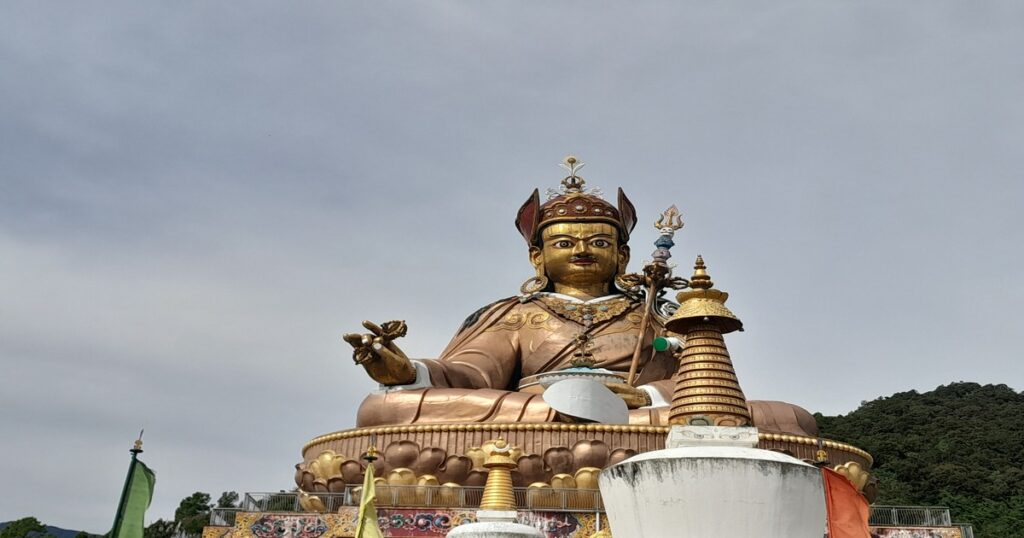
Significance of Guru Rinpoche in Bhutan
The significance of Guru Rimpoche in Bhutan:
Introduction of Buddhism: Guru Rimpoche introduced Buddhism to Bhutan in the 8th century AD. He established the Nyingma sect of Tibetan Buddhism, one of the oldest schools of Tibetan Buddhism.
Subduing Evil Spirits: During his visits to Bhutan, Guru Rimpoche subdued many evil spirits and converted them into protecting deities of different valleys across the country.
Blessing Sacred Sites: Guru Rimpoche meditated and blessed numerous sacred sites throughout Bhutan, including the Tiger’s Nest Monastery (Taktsang) in Paro, Singye Dzong, and Mebartsho in Bumthang.
Hiding Treasures: Guru Rimpoche hid many kinds of treasures to be rediscovered by treasure revealers, which are believed to have spiritual significance and power.
Establishing the Beyul: Bhutan is called the Beyul (hidden land), a legacy of Guru Rimpoche. He is credited with establishing Bhutan as a sacred and spiritually significant place.
Spiritual Legacy: Guru Rimpoche’s teachings and contributions to Buddhist civilization are deeply revered in Bhutanese society.
When did Guru Rinpoche die?
Guru Rinpoche is believed to have attained the “rainbow body of great transference,” a state in which his physical body was transformed into light and thus never died. He is not an ordinary human being – he is beyond time and age as we know it.
Conclusion
Guru Rinpoche, revered as the “Second Buddha,” significantly shaped Bhutan’s religious landscape by introducing Buddhism in the 8th century. He visited Bhutan three times, starting in 810 AD, subduing evil spirits and converting them into protective deities. These actions led to the establishment of numerous sacred pilgrimage sites (Neys) across the country, where he meditated and left treasures (Ter) to be discovered by treasure revealers (Tertons). His first visit was to recover the life force of King Sindhu Raja. You can visit the sacred sites of Guru Rinpoche in Bhutan with the Bhutan Pilgrimage Package.
Frequently Asked Questions
When was Guru Rinpoche born?
Guru Rinpoche was born in 717 AD in the Kingdom of Oddiyana from a lotus flower as an eight-year-old child.
Where was Guru Rinpoche born?
Guru Rinpoche was born in the Kingdom of Oddiyana, the Swat valley of what is now Pakistan.
How was Guru Rinpoche born?
Guru Rinpoche was born consciously as an eight-year-old by taking a miraculous birth in Lake Dhanakosha from the center of a lotus.
Is Guru Rinpoche a Buddha?
Yes, Guru Rinpoche is considered a Buddha. He is revered as the second Buddha and is known for his fully enlightened state, which is believed to be even more enlightened than Buddha Shakyamuni.
When did Guru Rinpoche come to Bhutan?
Guru Rinpoche came to Bhutan in 810 A.D.
Why did Guru Rinpoche come to Bhutan?
Guru Rinpoche came to Bhutan at the invitation of King Sindhu Raja of Bumthang to recover his life force (sog) snatched by the local deity, Shelging Karpo.
How is Guru Rinpoche important to us?
Guru Rinpoche is important to us as one of Bhutan’s most important historical and religious figures, known for introducing Buddhism. His teachings and contributions to Buddhist civilization are deeply respected in Bhutanese society, and his statue appears in almost all Bhutanese temples and homes.
What did Guru Rinpoche do to Bhutan?
During his visits to Bhutan in the 8th century, Guru Rimpoche made significant contributions to the spread of Buddhism and the spiritual development of the country:
- He subdued many evil spirits and converted them into protecting deities of different valleys across Bhutan.
- He meditated and blessed many places as holy sites for pilgrimage (Neys) throughout the country. Some prominent sites he blessed include the Tiger’s Nest Monastery (Taktsang) in Paro, Singye Dzong, and Membartsho in Bumthang.
- He hid many kinds of treasures (Ter) to be rediscovered in the future by Tertons (treasure revealers).
- He is credited with introducing Buddhism to Bhutan. Bhutan is called the Beyul (hidden land), the virtuous legacy of Guru Rimpoche.
- He established the Nyingma sect of Buddhism, one of the oldest schools of Tibetan Buddhism.
What are the contributions of Guru Rinpoche to Bhutan?
Guru Rimpoche made significant contributions to Bhutan in various aspects:
- Spread of Buddhism: Guru Rimpoche introduced Buddhism to Bhutan, establishing the Nyingma sect of Tibetan Buddhism.
- Subdued Evil Spirits: During his visits, Guru Rimpoche subdued many evil spirits and converted them into protecting deities of different valleys across Bhutan, ensuring the spiritual well-being of the people.
- Blessed Sacred Sites: Guru Rimpoche meditated and blessed numerous sacred sites throughout the country, which are now considered holy sites for pilgrimage.
- Hid Treasures: Many treasures (Ter) were hidden by Guru Rimpoche to be rediscovered by Tertons (treasure revealers).
Why did Guru Rinpoche come to Bhutan for the first time?
Guru Rinpoche first came to Bhutan in 810 A.D. at the invitation of King Sindhu Raja of Bumthang to recover his life force (sog) snatched by the local deity, Shelging Karpo.
Why did Guru Rinpoche come to Bhutan for the second time?
Guru Rinpoche came to Bhutan for the second time with Khandro Yeshe Tshogyal from Tibet in 822 A.D., as per the prophecy to subdue evil spirits and spread Buddhism in the country.
Why did Guru Rinpoche come to Bhutan for the third time?
Guru Rinpoche came to Bhutan for the third time in 876 AD to subdue all the demons and establish Buddhism in Monyul. It was his final visit to Bhutan.
How would the life of the Bhutanese be if Guru Rinpoche had not visited?
If Guru Rinpoche had not visited Bhutan, the lives of Bhutanese people would likely be significantly different in several aspects:
- No Introduction of Buddhism: Guru Padmasambhava introduced Buddhism to Bhutan. Without his visit, the people might have continued to follow their traditional animistic practices.
- No Subjugation of Evil Spirits: Guru Padmasambhava subdued many evil spirits and converted them into protecting deities of different valleys across Bhutan. Without his visit, these spirits might have continued to cause harm and chaos, affecting the people.
- No Sacred Sites: Guru Padmasambhava blessed numerous sacred sites throughout the country. The people might not have had access to these spiritual centers without his visit.
- No Hidden Treasures: Guru Padmasambhava hid many treasures (Ter) to be rediscovered by Tertons (treasure revealers). The people might not have had access to these spiritual resources without his visit.
- Different Cultural and Spiritual Heritage: Guru Rinpoche’s teachings and contributions to Buddhist civilization have profoundly impacted Bhutanese society. Without his visit, Bhutan’s cultural and spiritual heritage might be significantly different, and the people might not have developed the same spiritual practices and traditions.
Why do you think the important dates related to Lord Buddha and Guru Rinpoche are declared as holidays?
The important dates related to Lord Buddha and Guru Padmasambhava are declared holidays in Bhutan because they are deeply significant to the country’s Buddhist heritage and cultural identity. These dates honor the introduction of Buddhism, the life and teachings of Guru Padmasambhava, and the nirvana of Lord Buddha, while also reflecting the country’s strong cultural traditions and national identity.
Where is Guru Rinpoche now?
After spreading Buddhism in the world, Guru Rinpoche is believed to have traveled to the land of the demon rakshasas in Chamara and continues to visit his disciples regularly, especially on the tenth and twenty-fifth days of the lunar month, returning astride the beams of the rising and setting sun. Therefore, Guru Rinpoche is always with us today.
Enjoyed reading this blog?

